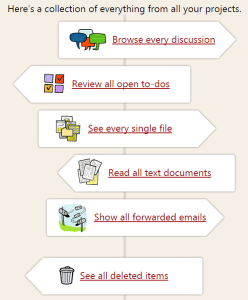 I have been exploring business tools pretty consistently over the last three months, including Tools I use to amplify social campaigns, IF you haven’t THEN you should use IFTTT for social, GetResponse makes it easiest to start an email newsletter compared to Aweber and MailChimp, My online influencer research and engagement process, Your social media marketing automation solution, Social media content discovery and curation for the win, The best automagical Twitter following tools for your business, and ManageFlitter is my favorite follow/unfollow Twitter tool. Today, I will share the project management tools that I have used. It all came down to the Goldilocks test: Asana was too hard, Trello was too soft, and Basecamp was just right.
I have been exploring business tools pretty consistently over the last three months, including Tools I use to amplify social campaigns, IF you haven’t THEN you should use IFTTT for social, GetResponse makes it easiest to start an email newsletter compared to Aweber and MailChimp, My online influencer research and engagement process, Your social media marketing automation solution, Social media content discovery and curation for the win, The best automagical Twitter following tools for your business, and ManageFlitter is my favorite follow/unfollow Twitter tool. Today, I will share the project management tools that I have used. It all came down to the Goldilocks test: Asana was too hard, Trello was too soft, and Basecamp was just right.
Basecamp
 Basecamp was the first tool I chose back when I started Abraham Harrison, until my team mutinied and made me us Central Desktop, which I never cottoned to (note to self: look up “assertiveness training dc” on Google). I have gone through CD, Google Sites, the Google Inbox hell, a very harried assistant and project manager, and then Trello, Asana, and then back to Basecamp. It works.
Basecamp was the first tool I chose back when I started Abraham Harrison, until my team mutinied and made me us Central Desktop, which I never cottoned to (note to self: look up “assertiveness training dc” on Google). I have gone through CD, Google Sites, the Google Inbox hell, a very harried assistant and project manager, and then Trello, Asana, and then back to Basecamp. It works.
Basecamp’s pretty affordable after their free 60-day “all you can eat” trial. That gives me plenty of room as a singleton agency with an infinity of partners, colleagues, referral networks, and all that. I’m already using 27/40 projects and have dozens of people as colleagues or clients running through the live projects.
 Basecamp allows me to really start juggling projects without losing balls. I’ll start up a project the moment I get onto a BD call and I’ll save everything in my Basecamp project from the proposal to the contract to the NDA to the signed contract to all the primer docs that help me and my team read into the project. I include invoices and and all that stuff, all of which I can label and I won’t lose just as long as I can scrape together $50/month. Keeping everything together, and being able to keep everything separated make things pretty simple and helps a lot with version control.
Basecamp allows me to really start juggling projects without losing balls. I’ll start up a project the moment I get onto a BD call and I’ll save everything in my Basecamp project from the proposal to the contract to the NDA to the signed contract to all the primer docs that help me and my team read into the project. I include invoices and and all that stuff, all of which I can label and I won’t lose just as long as I can scrape together $50/month. Keeping everything together, and being able to keep everything separated make things pretty simple and helps a lot with version control.
 basecamp also allows me to easily segregate internal from external, though I need to be careful with that. I can upload all the files associated with each project instead of mucking about with Google Docs and Dropbox, though you can integrate Google Docs files with Basecamp (no Dropbox integration yet, maybe never, but that’s OK). The best thing about Basecamp in my industry — the agency work — is that 100% of everyone I work with already has Basecamp experience.
basecamp also allows me to easily segregate internal from external, though I need to be careful with that. I can upload all the files associated with each project instead of mucking about with Google Docs and Dropbox, though you can integrate Google Docs files with Basecamp (no Dropbox integration yet, maybe never, but that’s OK). The best thing about Basecamp in my industry — the agency work — is that 100% of everyone I work with already has Basecamp experience.
While none of my colleagues ache for Basecamp, and most are solidly in either the I Love Trello or the I Love Asana camp, most everone will work with me on Basecamp if I push a little bit — even my quirky Indian team, who would really prefer using Asana exclusively, have done a great job using Basecamp because email integration is so tight that some clients never actually log in to Basecamp but do all of their work via email replies.
You can pretty much do all your important dialoguing via email. Plus, Basecamp has a gorgeous app for both iPhone iOS and Android (but so do Trello and Asana). There are some things I don’t like. Basecamp isn’t good at all with the sort of creative recurring calendar events that are simple using Outlook and other modern calendaring tools. The Event calendaring features on Basecamp seem a little bit like an afterthought, though they do offer excellent calendar integration of the iCal sharing format. Good stuff. Verdict: Just Right
Trello
 Trello is perfect on paper, and I love it and have recommended it to hundreds of people. It’s playful and visual and easy to use. It’s a visual, analog, method for doing and making things. It would be a perfect tool to use to write a book, build a house, organize an outing, plan a wedding, build a product, but for me and my agency, it doesn’t work, mostly because moving tasks (cards) across lists doesn’t change the status of that card. So, even if I move it into the “done” category/list, it doesn’t check off that task. You need to do that by hand. I’ll use Trello for all my personal tasks and when I finally start working on making Hillmole into a real book; however, it just can’t move as quickly or be as persistent over time as Basecamp is, for me and Gerris Corp. Verdict: Too Soft
Trello is perfect on paper, and I love it and have recommended it to hundreds of people. It’s playful and visual and easy to use. It’s a visual, analog, method for doing and making things. It would be a perfect tool to use to write a book, build a house, organize an outing, plan a wedding, build a product, but for me and my agency, it doesn’t work, mostly because moving tasks (cards) across lists doesn’t change the status of that card. So, even if I move it into the “done” category/list, it doesn’t check off that task. You need to do that by hand. I’ll use Trello for all my personal tasks and when I finally start working on making Hillmole into a real book; however, it just can’t move as quickly or be as persistent over time as Basecamp is, for me and Gerris Corp. Verdict: Too Soft
Asana
 I was obsessed with a program for the Mac back in the 90s that was an outliner with an embedded check box task tool. I was able to create the most amazing threaded task lists, each cascade under a general topic or heading. I forget what it was called but it was amazing. Asana reminds me of this, though it’s not an outliner, it’s more like Asanapedia or Wikitasks.
I was obsessed with a program for the Mac back in the 90s that was an outliner with an embedded check box task tool. I was able to create the most amazing threaded task lists, each cascade under a general topic or heading. I forget what it was called but it was amazing. Asana reminds me of this, though it’s not an outliner, it’s more like Asanapedia or Wikitasks.
It’s brilliantly put together, using plaintext in beautifully structured ways. All my techs love it as there’s a programmatic elegance to it. It has everything Basecamp has and more, but when you cross off/check off tasks, they sort of go away, if you don’t know what you’re doing.
I might give Asana some slack as I have not ponied up the $21/month to really get a feel for the premium app — everything that they offer in the premium mode are the things that I really love about Basecamp and really hate about my free version of Asana: private teams and projects and company-wide dashboards. I am sure if I pay up, I’ll have an experience that gets much closer to Basecamp.
I don’t know if that’s true, though, because I just don’t like the way Asana is set up, with the traditional email format of the list of projects on the left and a big display window for working on the right. I actually run my entire business on a 12″ laptop screen so it’s important for me to optimize everything that I use on my desktop and Basecamp, to me, feels the least cluttered and the easiest for me to maneuver.
But, I am might change my mind when I plop down some moola and unlock what I covet the most (and what I have on Basecamp): company-wide dashboards so I can get a 30,000 foot view of the very complex machine that Gerris Corp has become. It’s just not working for me for now, though there are some zealous devotees. Verdict: Too Hard
Summary
So, I am currently begging my Asana and Trello friends to come over and play on my Basecamp install. So far, so good. I am finding that everyone I have spoken to already have one or more Basecamp logins already since Basecamp launched over eleven years ago, way back in 2004. They kind of nailed it then and have been cracking it ever since. I tried to join the Highrise train but the CRM sucks so I abandoned it when the trial ended. Oh well.
Let me know what you think. I hope I have been able to make your decision a little easier. This all comes down to my own experience and subjective preference but I really could have been using Basecamp since I started my first agency way back in 2006 until now instead of mucking about with all these other tools that actually just muddied up the water instead of making everything crystal clear.
Good luck and go git ’em, tiger!






